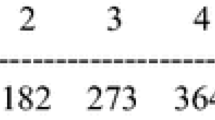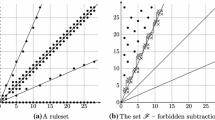Abstract
In this paper we analyze a recently proposed impartial combinatorial ruleset that is played on a permutation of the set \(\left[ n\right] \). We call this ruleset Stirling Shave. A procedure utilizing the ordinal sum operation is given to determine the nim value of a given normal play position. Additionally, we enumerate the number of permutations of \(\left[ n\right] \) which are \(\mathcal {P}\)-positions. The formula given involves the Stirling numbers of the first-kind. We also give a complete analysis of the Misère version of Stirling Shave using Conway’s genus theory. An interesting by-product of this analysis is insight into how the ordinal sum operation behaves in Misère Play.

Similar content being viewed by others
Notes
This fact explains the name of the ruleset.
This is often called the Grundy value but since the value is equal to the size of a nim heap, ‘nim value’ is the more modern term.
References
Albert M, Nowakowski RJ, Wolfe D (2007) Lessons in play: an introduction to combinatorial game theory. A. K. Peters
Berlekamp ER, Conway JH, Guy RK (1982) Winning ways. Academic Press, London
Bernstein M, Sloane N (1995) Some canonical sequences of integers. Linear Algebra Appl 226(228):57–72
Bouton CL (1902) Nim, a game with a complete mathematical theory. Ann Math 3(2):35–39
Brown JI, Cox D, Hoefel A, McKay N, Milley R, Nowakowski RJ, Siegel AA (2017) Polynomial profiles of placement games. Games of no chance 5. (to appear)
Conway JH (1976) On numbers and games. Academic Press
Farr GE (2003) The Go polynomials of a graph. Theor Comp Sci 306:1–18
Grundy PM (1939) Mathematics and games. Eureka
Hetyei G (2009) Enumeration by kernel positions. Adv Appl Math 42(4):445–470
Hetyei G (2010) Enumeration by kernel positions for strongly Bernoulli type truncation games on words. J Combin Theory Ser A 117:1107–1126
McKay NA (2016) Forms and values of number-like and nimber-like games. Dalhousie University, Ph.D
McKay NA, Milley R, Nowakowski RJ (2015) Misère-play Hackenbush Sprigs. Int J Game Theory 45:1–12
Nowakowski RJ, Ottaway P (2011) Option-closed games. Contrib Disc Math 6:142–153
Nowakowski RJ, Renault G, Lamoureux E, Mellon S, Miller T (2013) The game of Timber!. J Combin Math Combin Comput 85:213–225
OEIS Foundation Inc. (2011) The on-line encyclopedia of integer sequences. http://oeis.org. A089064
Siegel AA (2011) On the structure of games and their posets. Dalhousie University, Ph.D
Siegel AN (2013) Combinatorial game theory. American Math. Soc
Sprague RP (1935) Über mathematische Kampfspiele. Tohoku Math J
Author information
Authors and Affiliations
Corresponding author
Additional information
This work was partially funded by Fundação para a Ciência e Tecnologia through the project UID/MAT/04721/2013.
Rights and permissions
About this article
Cite this article
Fisher, M., Nowakowski, R.J. & Santos, C. Sterling stirling play. Int J Game Theory 47, 557–576 (2018). https://doi.org/10.1007/s00182-017-0598-2
Accepted:
Published:
Issue Date:
DOI: https://doi.org/10.1007/s00182-017-0598-2




